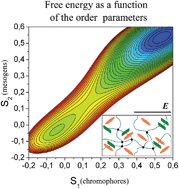Light-induced deformation of polymer networks containing azobenzene chromophores and liquid crystalline mesogens
Abstract
Two-component polymer networks containing liquid crystalline (LC) mesogens and azobenzene chromophores belong to a class of smart materials which combine uniquely the orientation order of liquid crystals and light-induced deformation of photosensitive polymers. In the present study we develop a theory of light-induced deformation of azobenzene-containing LC networks. It is shown that preferential reorientation of chromophores perpendicular to the polarization direction of the light E leads to the reorientation of the mesogens due to LC interactions between the components. Reorientation of the chromophores and mesogens results in the light-induced deformation of the polymer network. The sign of deformation (expansion/contraction with respect to the vector E) depends on the orientation distribution of the mesogens and chromophores inside the network strands. The magnitude of deformation increases with increase of the volume fraction of chromophores and the strength of LC interactions between the components. The influence of the dilution of azobenzene-containing networks by the bent cis-isomers of the chromophores on the light-induced deformation is discussed.


 Please wait while we load your content...
Please wait while we load your content...